If you have an app or game on your Windows 11 or Windows 10 device that you would like to go full screen on but can’t find the full-screen, windowed, or border-less options, this short tutorial will show you how to go full screen on most apps, games or browsers.
Also see: Stop Games From Minimizing on Dual Monitors Windows 11
Universal full-screen shortcut keys
In most apps or games, you can use the universal full-screen shortcut keys – the Alt + Enter keys combination, which usually works to change an app or game into full-screen mode immediately.
To enter full screen on an app or game, while you are on the app or game, press Alt + Enter keys on your keyboard. The app should then switch itself into full-screen mode.
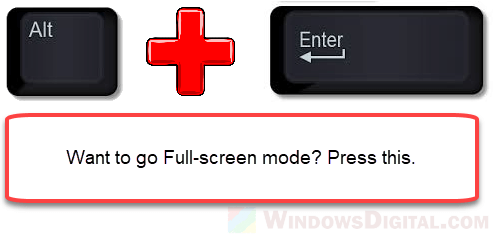
Please note that this method won’t work to go full screen on browsers in Windows. To enter full screen on a browser, use the second method below instead.
Going full screen on browsers such as Chrome, Edge or Firefox in Windows 11 or 10
Going full screen on browsers is different than that of other apps. The Alt + Enter keys will not work to switch browsers to full screen on Windows 10/11.
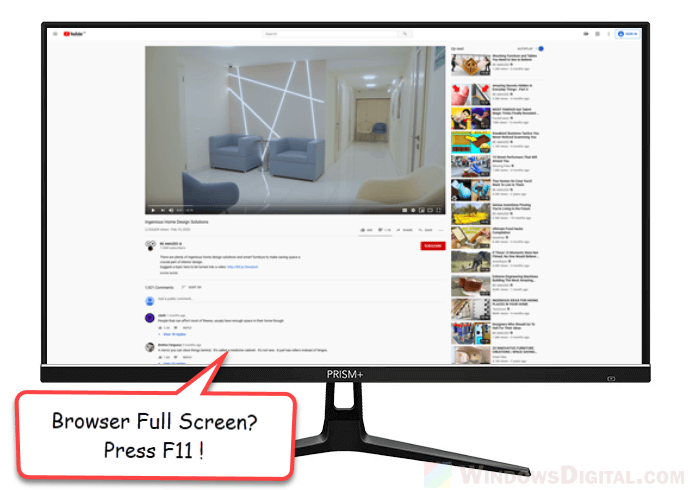
The magic shortcut key for most browsers to go full screen is the F11 key. To open a webpage in full-screen mode on Chrome, Edge, or Firefox, while you are on the webpage, press the F11 key on your keyboard. The page should then cover your entire screen, achieving a borderless full-screen effect.
Going full screen on Chrome without F11 key
If your keyboard doesn’t have an F11 key or it’s not functioning properly, you can still go full screen on Chrome by using the menu options.
- Open Chrome and navigate to the webpage you want to view in full screen.
- Click the three-dot menu icon in the top-right corner of the window.
- Hover your mouse over the “Zoom” option in the menu that appears.
- Click on the “Fullscreen” option in the sub-menu that appears.
- The webpage should now be displayed in full screen mode.
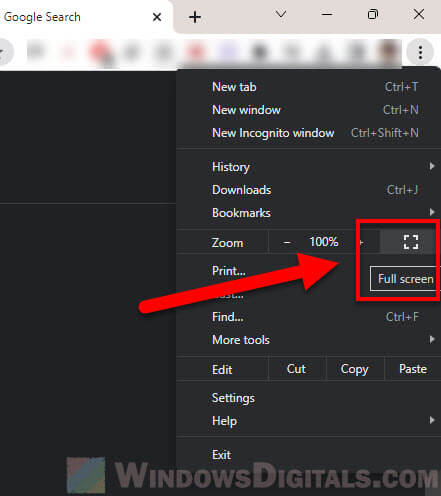
Alternatively, you can also use the keyboard shortcut Ctrl + Shift + F to go full screen on Chrome without using the F11 key.
Keep in mind that not all versions of Chrome may have the “Fullscreen” option in the Zoom menu, and some websites may not allow you to go full screen through this method. In those cases, you may need to use a different browser or find a workaround specific to that website or app.
How to exit full screen on Windows 10 or 11
If it’s an app or a game, to get out of full-screen mode, try to use the same shortcut keys – Alt + Enter keys again to switch back to windowed mode. The Alt + Enter shortcut key is actually a toggle button to switch between full-screen and windowed mode on most apps or games.
If it’s a browser, simply press F11 keys to revert back to windowed mode. Similar to the Alt + Enter keys method, F11 key is also a toggle button to switch between full-screen and windowed mode in most modern browsers.
Still can’t get full screen on your app or game?
The methods above may not work on certain modern apps or games if they don’t allow such shortcut keys that may interfere with the apps to exist.
If that’s the case, you have to try to look for any available in-game video options or configurations that allow you to manually modify the screen settings to full-screen mode. It’s usually called “Display mode” or “Screen mode” which can usually be found under Video Settings or Graphic Options in most apps or games if there is any.
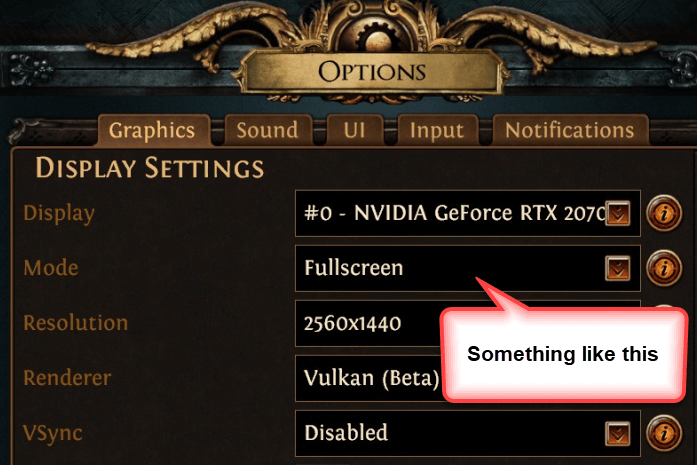
Some apps or games don’t allow full-screen mode at all, in which case, there is no way you can change it to full-screen mode.
Readers help support Windows Report. We may get a commission if you buy through our links.
Read our disclosure page to find out how can you help Windows Report sustain the editorial team. Read more
Microsoft is changing the way Windows 10 operates with modern apps. These apps are running inside a window on the desktop and they are windowed like traditional applications, by default.
Users of Windows 10 now have the option to toggle fullscreen mode for apps in Windows 10. Apps such as Netflix, Edge, or the Paint 3D feature controls for minimizing, maximizing, and closing the app window.
Games will usually run in fullscreen mode, but there might be some apps that don’t feature such an option.
In the guide below we will show you how to run apps in full screen on Windows 10 using different methods.
How can I make an app full screen on Windows 10?
1. Use a keyboard shortcut
-
1. Press the Windows key to open the search box. Alternatively, you can press the Start button on your taskbar to open it.
-
2. Type the name of the app you want to open in full screen.
-
3. Click on the result to open the app.
-
4. Press the keys Alt + Enter to toggle full screen on.
-
5. Now your app should run in full screen on your monitor.
The fastest option available is using a keyboard shortcut to launch most Windows 10 apps in a dedicated full screen mode. This toggles the active Windows 10 app between normal and full screen mode.
The created shortcut can also be used to run games and apps that normally launch in fullscreen mode, in windowed mode.
2. Run the app in maximized mode
You can also configure the app to always open in full-screen mode by tweaking its properties on your desktop. Here is how:
- Create a shortcut for the app on your desktop.
- Right-click on it and select Properties.
- Enter the Shortcut tab.
- Select Run and choose Maximised from the list of available options.
- Click Apply and Ok to save the changes.
3. How to toggle full-screen mode in a browser
- Click to open your desired browser on your PC.
- Open a webpage on your browser. It can be any webpage you want.
- Press the F11 key.
- Now your browser is full screen.
- If you want to toggle the full-screen mode off, simply press F11 again.
3.1 Run Microsoft Edge in full-screen
Microsoft Edge used to not allow its users to toggle full-screen using the keyboard shortcut. However, things changed ever since, and the solution now works properly. This likely happened due to Microsoft Edge moving to the Chromium-based platform.
Another option available is using a shortcut to launch it in a dedicated fullscreen mode: Windows-Shift-Enter. This toggles the active Windows 10 app between normal and fullscreen mode.
- NieR: Automata resolution issues on Windows 10
- 9 Tested Ways to Fix Chrome if Full Screen Is Not Working
- How to go full screen in Windows 11
- How to Disable Fullscreen Optimizations on Windows 10/11
Windows 10 Fullscreen shortcut restrictions
- You cannot use Esc if you want to exit the fullscreen mode in a browser and you don’t have any indications displayed on the screen on how to leave it. You can still use the Alt-Tab combination, though.
- When using the shortcut to run Microsoft Edge in fullscreen mode, the address bar, and the tabs are not going to be displayed. If you want to navigate to other tabs, you can use keyboard shortcuts such as Ctrl-Shift-Tab or Ctrl-Tab. You can also use Ctrl-T, in case you want to open a new tab with options for loading a new web address.
- If you middle-click on right-click on certain links, they’ll open in new tabs.
That is it. It is quite simple to toggle fullscreen mode for apps in Windows 10.
Don’t hesitate to write us in the comment section found below if you have any questions.
Radu Tyrsina
Radu Tyrsina has been a Windows fan ever since he got his first PC, a Pentium III (a monster at that time).
For most of the kids of his age, the Internet was an amazing way to play and communicate with others, but he was deeply impressed by the flow of information and how easily you can find anything on the web.
Prior to founding Windows Report, this particular curiosity about digital content enabled him to grow a number of sites that helped hundreds of millions reach faster the answer they’re looking for.
Все способы:
- Способ 1: Клавиатура
- Способ 2: Редактирование свойств ярлыка
- Способ 3: Режим совместимости
- Способ 4: Изменение разрешения экрана
- Способ 5: Настройки игры
- Способ 6: Настройка ПО видеокарты
- Способ 7: Параметры запуска в игровых площадках
- Способ 8: Редактирование файла конфигурации
- Вопросы и ответы: 1
Чаще всего проблема с отображением в полноэкранном режиме появляется у устаревших игр, которые не поддерживают высокое разрешение и нестандартные мониторы. В некоторых случаях сделать ничего не удастся, но можно попробовать несколько альтернативных методов исправить ситуацию и развернуть интерфейс игры во весь экран.
Способ 1: Клавиатура
Если разработчики игры предусматривают возможность изменения отображения, то развернуть ее на весь экран можно с помощью стандартного сочетания клавиш – «Alt + Enter». Просто запустите игру и одновременно зажмите эти две клавиши.

Для того чтобы вернуть игру в оконный режим, используйте «Alt + Tab».
Следует отметить, что не всеми играми поддерживается это классическое сочетание клавиш, поэтому способ подойдет не всем.
Способ 2: Редактирование свойств ярлыка
Параметры запуска можно отрегулировать через свойства ярлыка. После соответствующих настроек игра должна сразу открываться на весь экран:
- Кликните правой кнопкой мыши по ярлыку и из контекстного меню выберите пункт «Свойства».
- В системном окне перейдите на вкладку «Ярлык». В меню «Окно» разверните список и выберите «Развернутое во весь экран».
- Также проверьте строку «Объект». Если в поле в конце есть параметр
–windowed, то это значит, что запуск настроен так, что приложение сразу открывается в оконном режиме. Сотрите эту команду, не трогая все то, что взято в кавычки. - Сохраните настройки, нажав на кнопку «ОК».
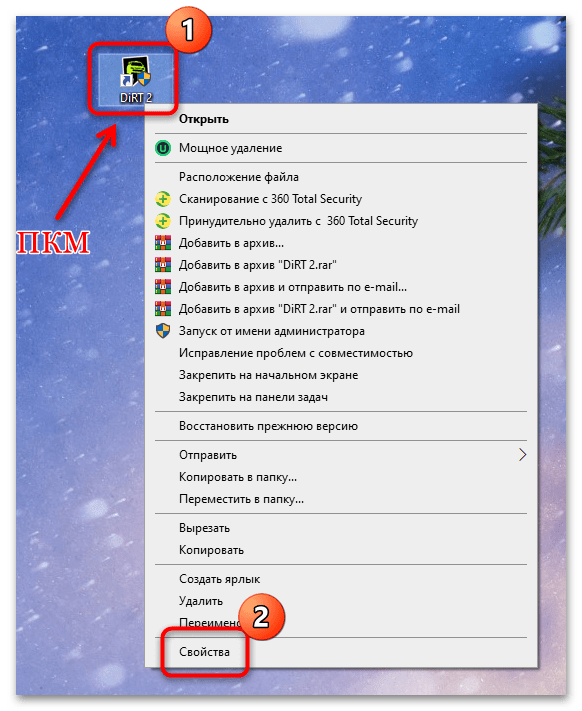
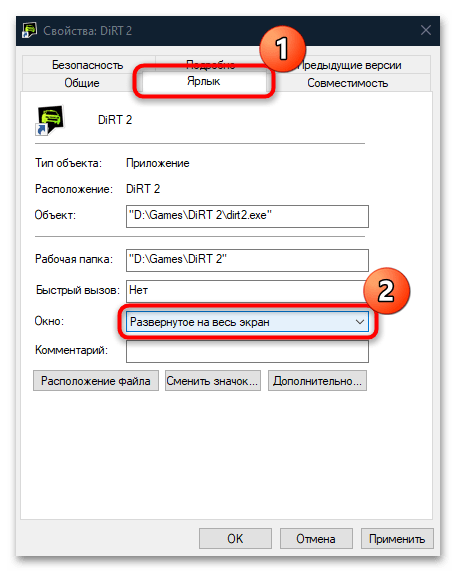
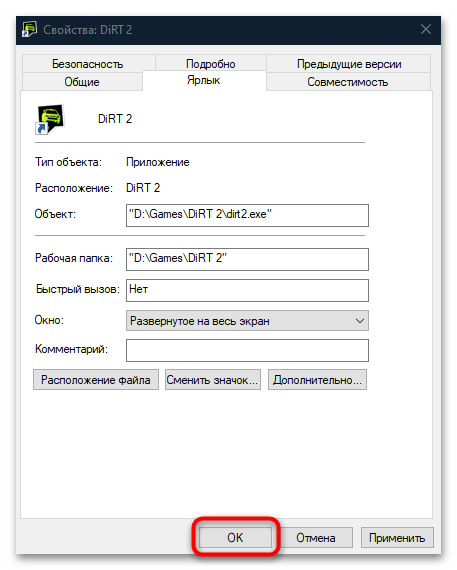

Способ 3: Режим совместимости
В некоторых случаях может помочь запуск проблемной игры в режиме совместимости с ОС, для которой она была изначально разработана. В результате она откроется в соответствии с теми параметрами, которые предусматривает система. Активируется режим через окно «Свойства»: откройте его так же, как в предыдущем способе, на вкладке «Совместимость» отметьте пункт «Запустить программу в режиме совместимости с:», затем выберите из выпадающего меню нужную операционную систему: от Windows 95 до Windows 8. Останется применить и сохранить настройки.
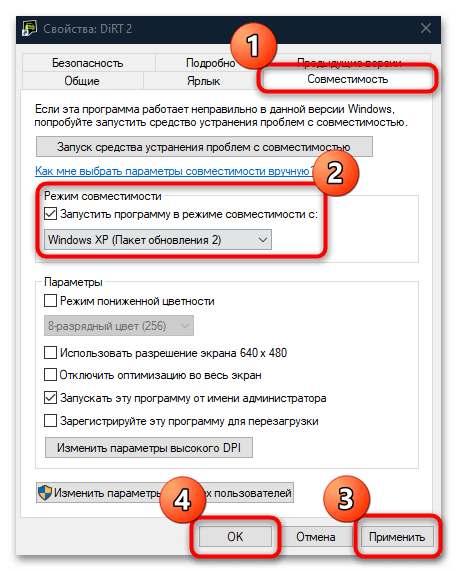
Способ 4: Изменение разрешения экрана
Если для игры выставлено слишком высокое разрешение, можно попробовать изменить его, выбрав значение параметра меньше, например 800×600, что подходит для многих устаревших игр. Делается через системное приложение:
- Кликните по свободной области рабочего стола и перейдите в «Параметры экрана».
- На вкладке «Дисплей» разверните меню «Разрешение дисплея» и выставьте один из меньших вариантов, чем сейчас.

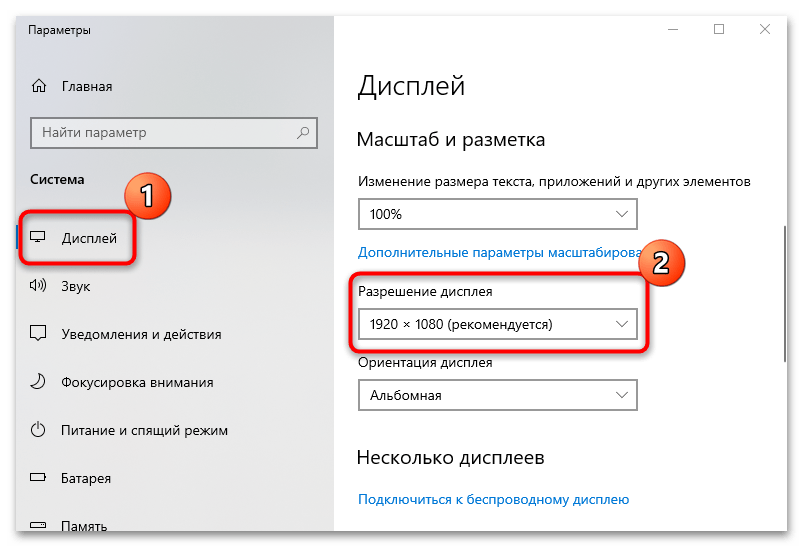
После этого достаточно попробовать запустить игру. Если она развернулась во весь экран, значит, дело действительно было в разрешении. Вернуть его можно аналогичным образом, с помощью нескольких кликов мышкой.
Читайте также:
Решение проблемы с отсутствием нужного разрешения экрана в Windows 10
Устранение проблем с изменением разрешения экрана на Windows 10
Также можно выставить масштаб (настройка находится там же, где и меняется разрешение экрана), выбрав рекомендуемое значение. Иногда и это оказывается эффективным.
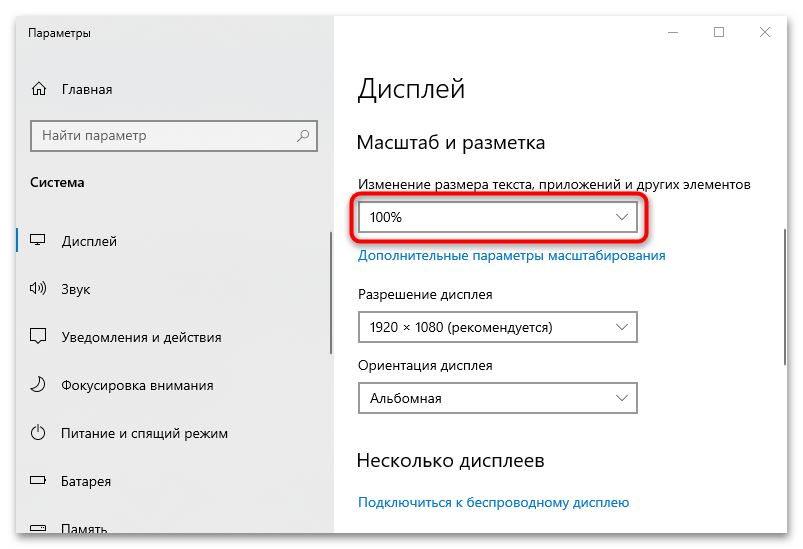
Способ 5: Настройки игры
Вероятно, оконный параметр запуска задан именно в игре. Обычно он располагается в соответствующем разделе графических настроек. Такая функция есть практически во всех играх, поэтому поищите ее и при необходимости поменяйте режим на «Полноэкранный» или «Fullscreen».
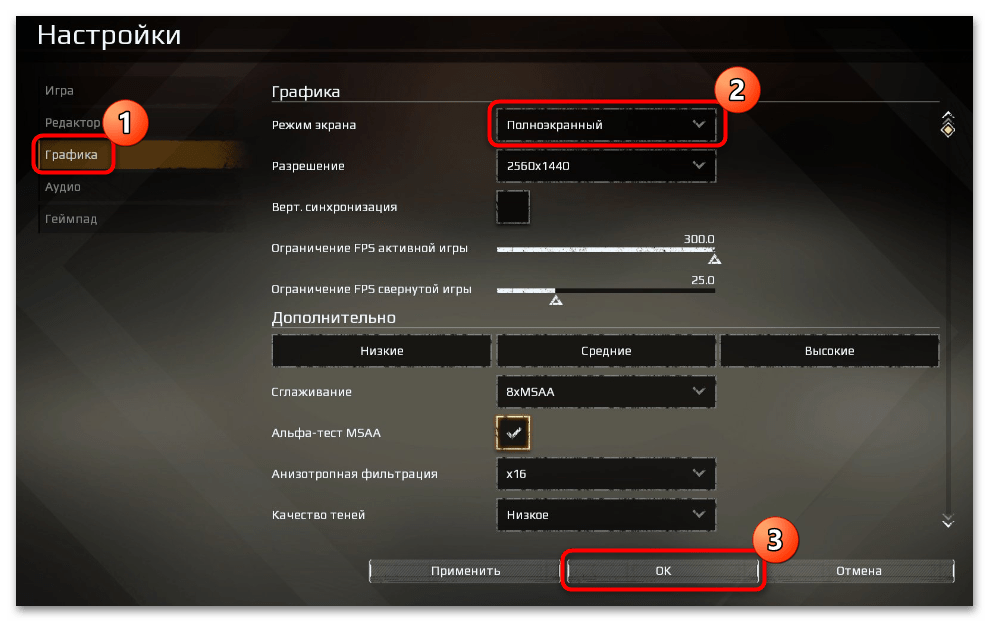
Способ 6: Настройка ПО видеокарты
Геймеры, предпочитающие старые игры, нередко сталкиваются с тем, что запустить проект в полноэкранном режиме не получается, а по бокам видны черные полосы. Это обусловлено тем, что ретроигры просто не поддерживают широкоформатные разрешения мониторов.
Исправить ситуацию могут помочь настройки фирменного софта для видеокарты, однако стоит понимать, что даже если получится убрать эти полосы, произойдет растягивание картинки. Покажем, как включить это в «Панели управления NVIDIA». Следует отметить, что не все модели видеокарт от NVIDIA предусматривают в настройках масштабирование.
- Щелкните правой кнопкой мыши по свободной области рабочего стола и через контекстное меню вызовите «Панель управления NVIDIA».
- На панели слева разверните «Дисплей» и выберите раздел с регулировкой размера и положения рабочего стола. В центральной части окна на вкладке «Масштабирование» выберите пункт «Во весь экран» и примените настройки.
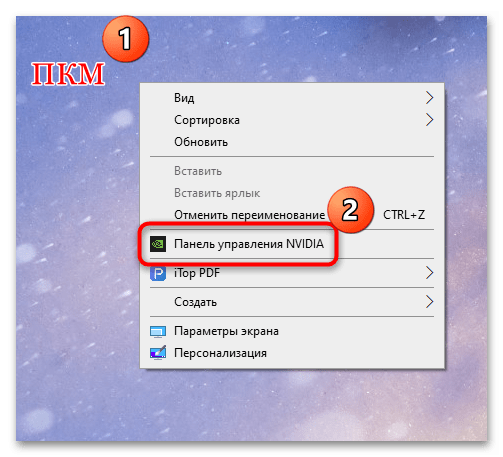

Кроме того, могут быть предусмотрены опции, которые позволяют играть в оригинальном разрешении или сохранять пропорции.
Читайте также: Неполадки в работе «Панели управления NVIDIA»
Настроить масштабирование могут и владельцы видеокарт AMD, используя одно из фирменных приложений. Как уже было сказано, зачастую изменение параметров масштаба через софт влечет за собой искажение изображения в играх. К примеру, в AMD Software: Adrenalin Edition это делается через настройки > «Дисплей» > «Режим масштабирования» > «Полная панель».
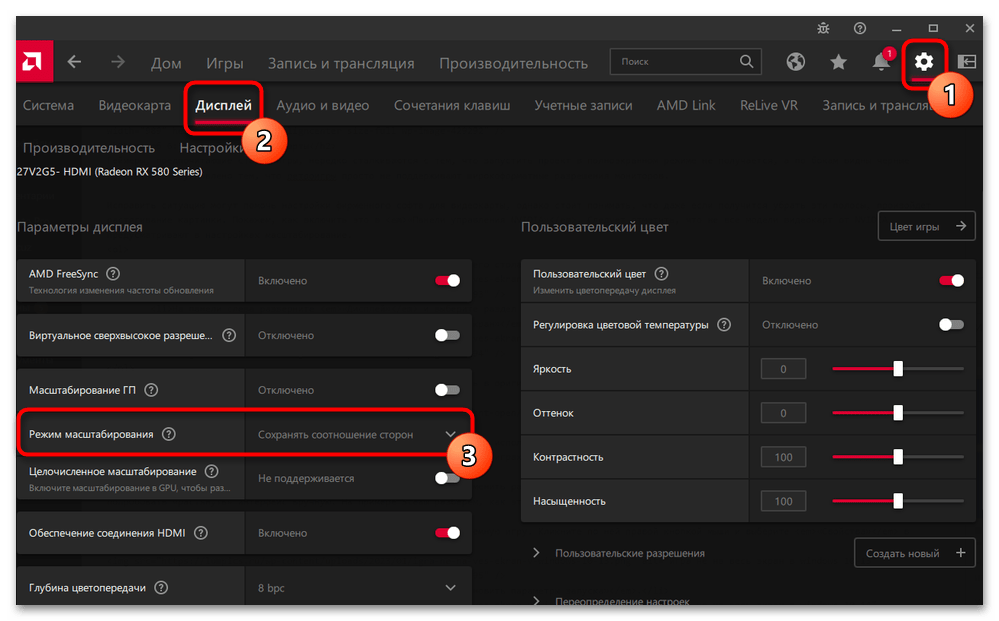
Способ 7: Параметры запуска в игровых площадках
Если ваша игра скачана через игровой сервис, изменить разрешение можно через настройку параметров запуска внутри клиента, тем самым попробовав растянуть игру вручную. На примере Steam разберем, как это сделать:
- Запустите Steam и в «Библиотеке» отыщите проблемную игру. Кликните по ней правой кнопкой мыши и выберите «Свойства» из дополнительного меню.
- На вкладке «Общие» найдите блок «Параметры запуска». В нем вы можете задать различные параметры, предварительно найдя их список в справочной информации самого игрового клиента или в интернете. Допустим, в Steam их немало: от сброса настроек и запуска игры в полноэкранном режиме до тонких настроек. В нашем случае нужно вручную задать ширину и высоту разрешения. Для этого в поле параметров запуска пропишите команды
–w(ширина) и–h(высота), после которых через пробел нужно ввести значения. Например, это может выглядеть так:-w 800 -h 600, что означает разрешение 800×600 пикселей — наиболее часто встречающийся вариант у различных старых игр, разработанных до начала 2000-х годов. После ввода сформированной команды достаточно закрыть это окно на крестик и попробовать запустить игру.
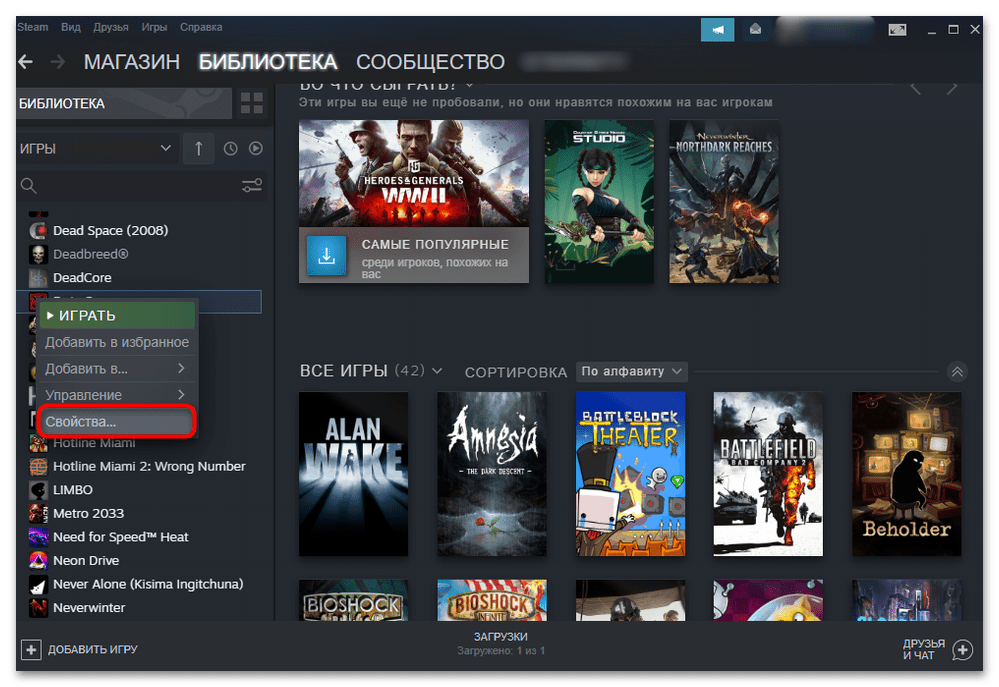
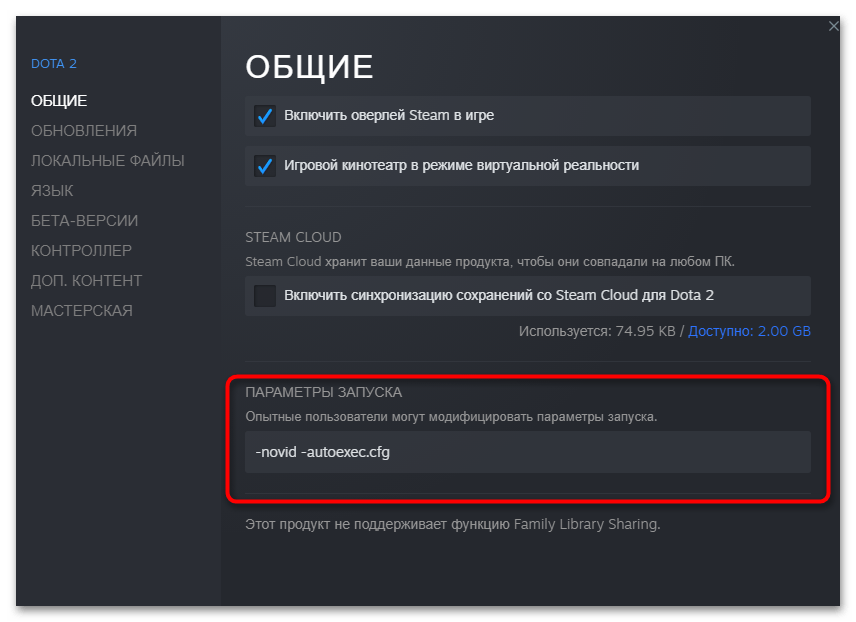
Чаще всего после того, как задается высота (команда -w), ширина рассчитывается автоматически в качестве оптимального решения, поэтому второе значение вручную вводить не обязательно.
Способ 8: Редактирование файла конфигурации
Еще один, но не самый удобный вариант — самостоятельное редактирование файла конфигурации игры, где надо выставить то разрешение, с котором она будет запускаться. По сути сама процедура не сложная, однако иногда может быть неочевидным расположение этого самого файла, поскольку он может быть в любом месте на диске. Иногда это корневой каталог с игрой, иногда папка «Мои документы» на системном томе. К этому вопросу придется подойти индивидуально: поискать на форумах подсказки или попробовать исследовать все возможные директории на локальных разделах.
Конфигурационный файл, как правило, носит расширение CFG, CNF, CONF, XML, INI и другие. Открываются все они через встроенный редактор «Блокнот».
Когда найдете файл конфигурации, лучше сделайте копию, чтобы можно было откатиться к настройкам по умолчанию, вернув оригинальный файл на место.
Например, файл конфигурации у Dirt 2 располагается в папке «Мои документы» по пути C:\Users\User_Name\Documents\My Games\DiRT2\hardwaresettings. Сам файл «hardware_settings_config» свободно редактируется через «Блокнот».
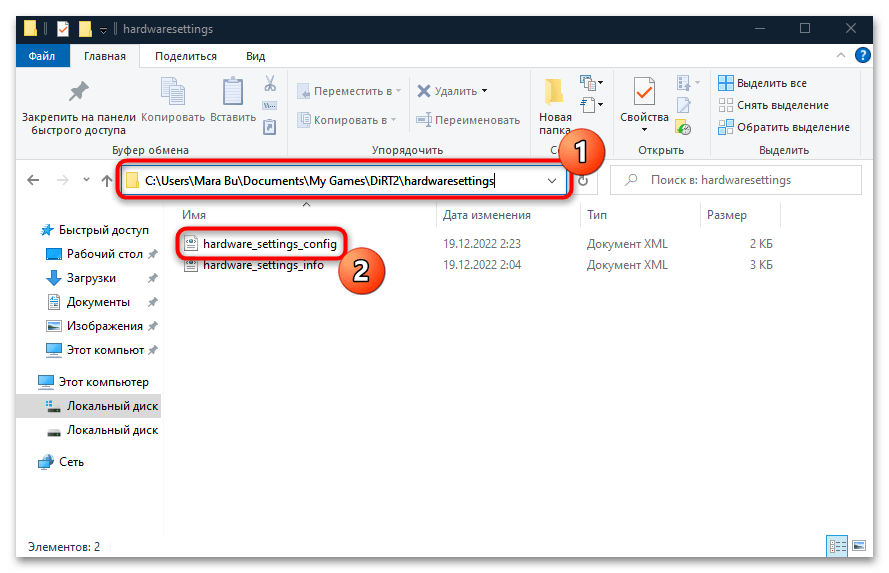
В списке параметров отыщите такие слова, как «width» (ширина) и «height» (высота). После знака равно внутри кавычек задано значение разрешения, в котором игра по умолчанию запускается. Попробуйте его поменять, например, на 800 и 600 соответственно, то есть строка будет выглядеть так: width="800" height="600".
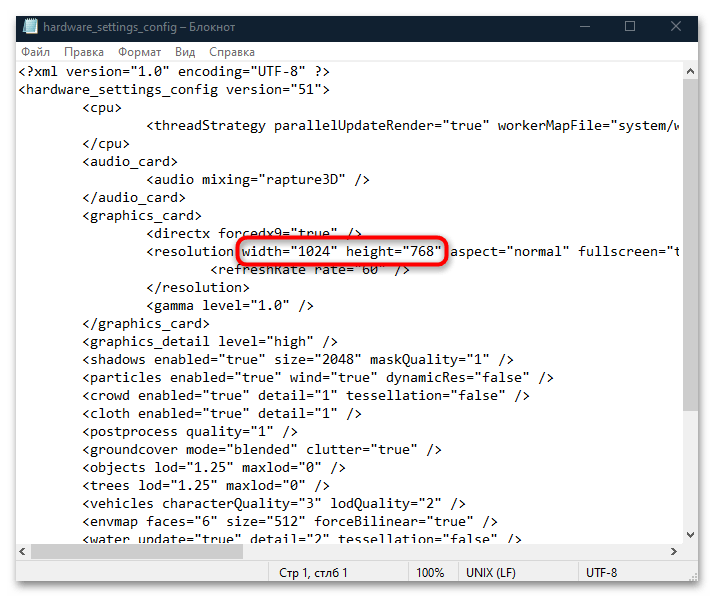
Также после определения разрешения может быть значение параметра fullscreen («Полный экран»). Если установлено «false», игра будет запускаться в оконном режиме. Замените его на "true".
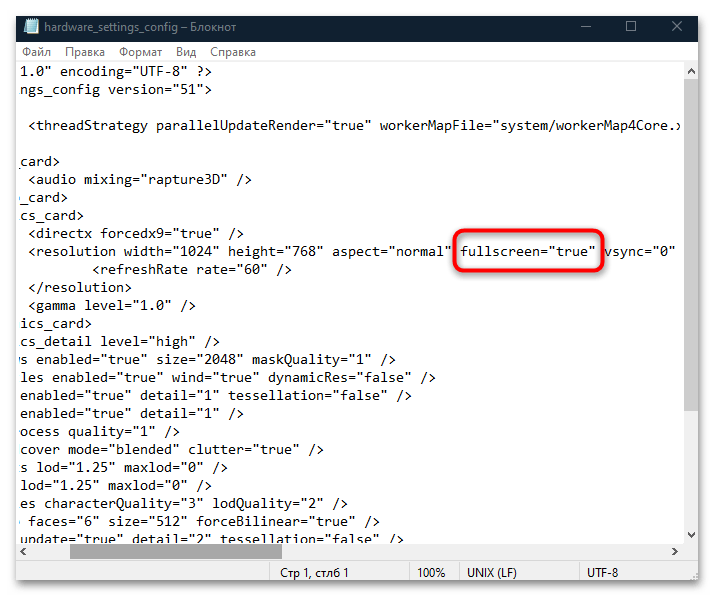
После того как в файл конфигурации были внесены изменения, сохраните их, закрыв окно «Блокнота» и выбрав соответствующий пункт в появившемся окне.
Наша группа в TelegramПолезные советы и помощь
It’s fun to immerse ourselves in games and focus without any distractions. Full-screen mode helps reduce distractions. In this article, we will show you how to go full screen in games as well as apps.
Some games and apps refuse to run fullscreen for a variety of reasons. Hopefully, this article will clear everything up and improve your Windows 10 experience.
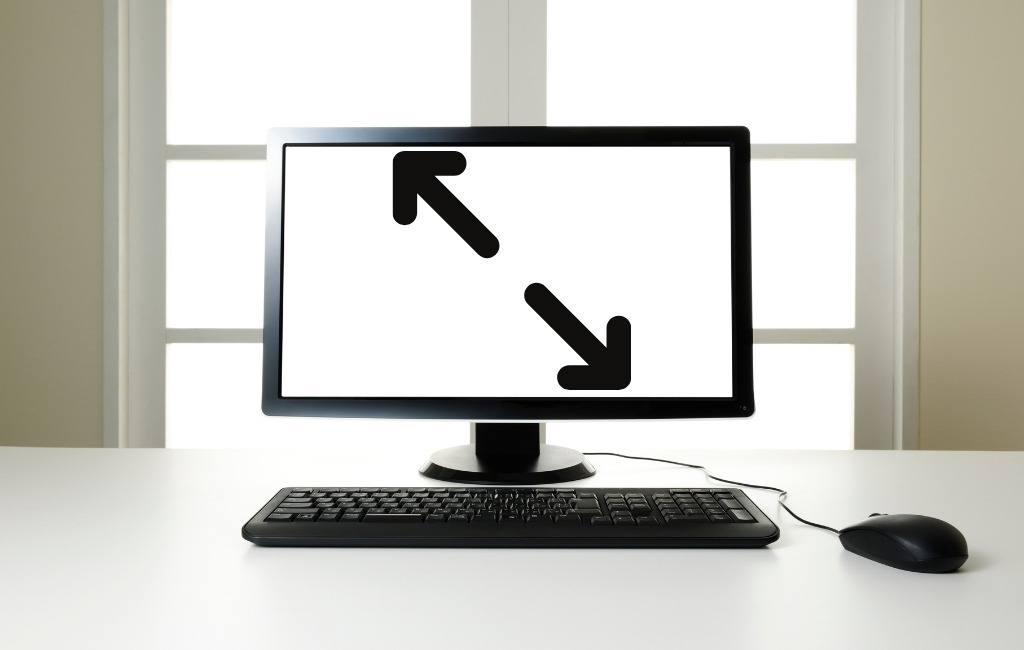
Full-Screen Mode Using Windows Shortcuts
The easiest way to go full screen in an application or a game is to use the Alt + Enter keyboard shortcut. This method works for most games and apps unless they use it to enable other features. The shortcut is also used to switch from full-screen mode to windowed.
Keep in mind the Alt + Enter shortcut doesn’t work in web browsers. To make a browser go full screen, press the F11 key, which is also one of the ways to exit full screen mode.

Open a webpage using a browser like Google Chrome, Firefox, or Edge and hit that key. The page should be displayed without a border, covering your whole screen.
Set the In-Game Display Settings to Fullscreen
If your game doesn’t launch in full-screen mode, you should check the in-game settings before anything else. The display mode might be set to Windowed by default.
To change display settings in your game, there should be a dedicated graphics panel that you access through the main menu. Depending on the game, the menu section might be called “Graphics Options,” “Display Settings”, or “Video Settings.” Look for Display Mode or something similar and set it to Fullscreen from the drop-down menu.
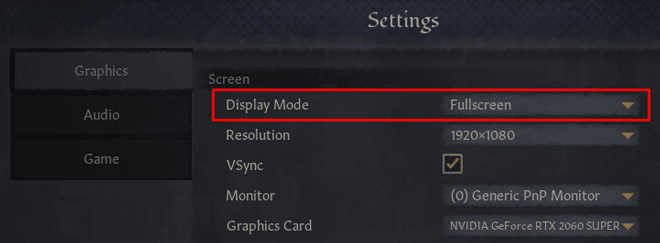
Save and apply the changes you’ve made.
Take note that some games might not switch to full-screen mode immediately. If that’s the case, restart your game.
Scale Your Display to 100%
Some games don’t behave properly in fullscreen mode due to the computer’s display scaling. To make sure this isn’t what’s keeping you from going full screen, open the Settings app, click on System, and select Display.
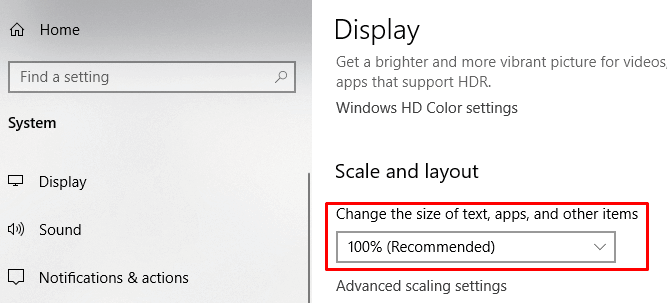
Set the “Change the size of text, apps, and other items” feature to 100%.
Switch the Main Monitor
While dual-monitor setups are extremely common these days, you might experience issues with some games. If you experience anything strange when trying to set your game or app to full screen, change your main monitor.
Launch your computer’s Display Settings window. When it opens, you’ll see two monitors, or more depending on your setup.
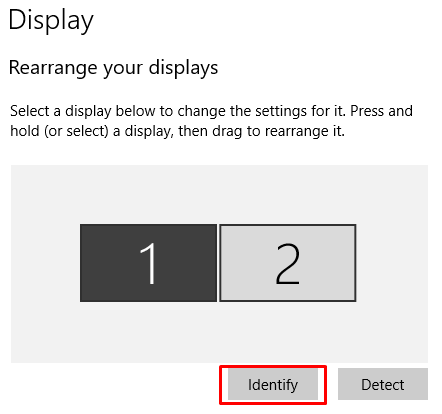
The screens are labeled with numbers. Click on Identify to see which monitor is which. Then you can change the order of your screens by dragging one of them on the opposite side. Save your changes and try running a game or app in fullscreen.
Tweak Your Graphics Card’s Settings
Windows 10 offers you a general application where you can change your main monitor, display resolution, and other settings. However, GPU manufacturers provide their own tools. Depending on your graphics card, you’ll have to make some adjustments inside one of these applications.
To change your graphics card’s settings, access one of the following applications:
- Intel Graphics Command Center: For integrated Intel graphics cards.
- Nvidia Control Panel: For Nvidia users.
- AMD Radeon Software: For AMD users.
You can access any of these applications by searching for them in the Windows start menu or search box. They look different and some of the settings are named differently, but in essence, they work the same.
We’re going to see how to go full screen by tweaking the Nvidia Control Panel settings. That said, you can use the steps below as a guideline and match these changes to your GPU’s own resolution center.
1. Access the Nvidia Control Panel found inside the Control Panel.
2. Choose Manage 3D settings under the 3D Settings tab and go to Global Settings.

3. If the Preferred graphics processor is set to Auto-select, switch it to High-performance Nvidia Processor. Sometimes the auto-select feature doesn’t enable your Nvidia GPU when launching a game, thus limiting you to the onboard graphics card.
Note: This option is available only if you have multiple GPUs. If the Nvidia GPU is the only one you have, this option is enabled by default.
4. Apply the changes and test full-screen mode in one of your games.
If the steps above didn’t work, you can try to adjust the desktop size and position. Here’s how you can do that:
1. Access the Nvidia Control Panel.
2. Click on Adjust desktop size and position, which is located under Display.
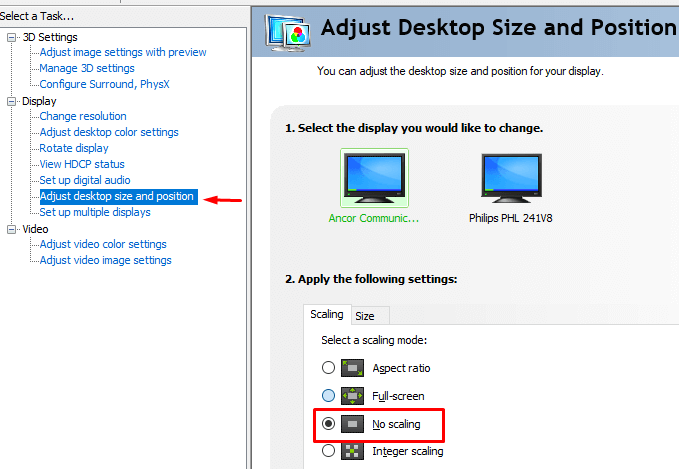
3. Set the scaling mode to No scaling and click on the Apply button.
Your games should now run in full-screen mode. If you’re an AMD user, apply the same changes in the AMD Radeon Software panel.
Run Games and Apps in Compatibility Mode
If you can’t run a particular app or game in full-screen mode, you’re probably having compatibility issues. This is usually the case with older games and programs that aren’t optimized for Windows 10.
To run the app/game in compatibility mode, right-click it, and go to Properties.
Open the Compatibility tab and under Compatibility Mode you will see a drop-down menu with various versions of Windows.
Make sure you first check the Run this program in compatibility mode for option and then choose an older Windows, like Windows 7 or even XP. Save the changes and test the game/app.
Set the Taskbar to Its Default Settings
Some games and apps might not run properly in full-screen if the Taskbar’s settings were altered. Some users report fixing their issues after moving the Taskbar back to the bottom of the screen.
If your Taskbar is not in its default location, right-click it and uncheck the Lock all taskbars option.
You can now move it by simply dragging it to the bottom. Once it’s in its place, make sure you lock it to not move it again by accident.
If this turns out to be the problem but you want to place your Taskbar elsewhere, you can set it to automatically hide in desktop mode.
To do that, run the Windows 10 Settings app and select Personalization. In the left panel, you’ll find the Taskbar settings. Set the Automatically hide the taskbar in desktop mode feature to On.
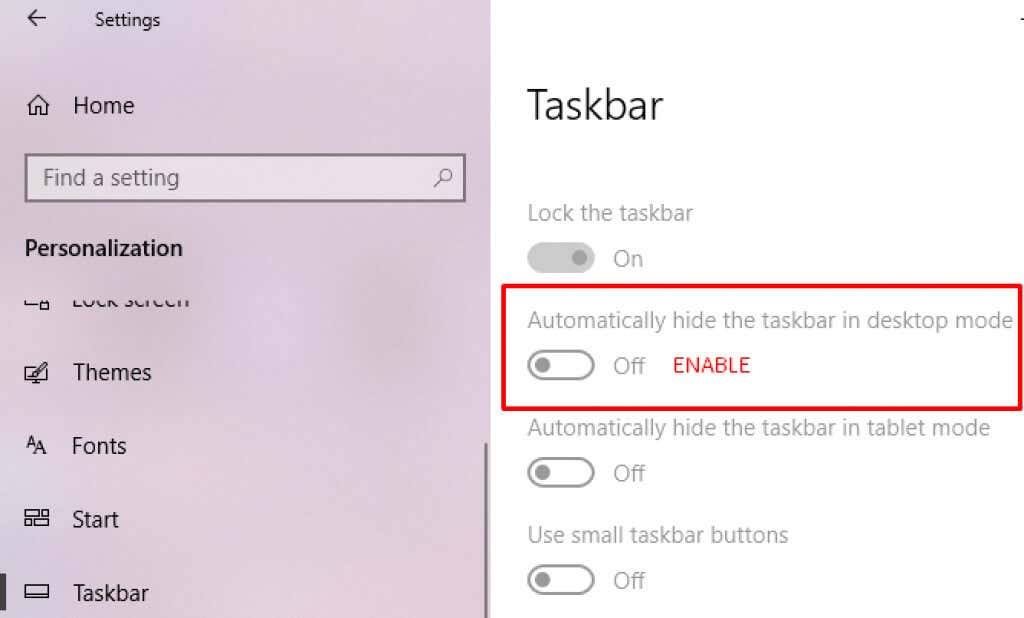
If your game or app has a full-screen option, one of the solutions should help. Let us know in the comments what worked for you.
Related Posts
- How to Fix a “This file does not have an app associated with it” Error on Windows
- How to Fix an Update Error 0x800705b4 on Windows
- How to Resolve “A JavaScript error occured in the main process” Error on Windows
- How to Fix the Network Discovery Is Turned Off Error on Windows
- How to Change Folder Icons in Windows
How to Full Screen Windows 11
Windows 11, Microsoft’s latest operating system, has introduced a plethora of changes and enhancements, one of the most notable being its visual aesthetics and user interface. As users adapt to this new environment, one functionality that remains crucial is the ability to use full screen mode effectively. Whether you’re gaming, working on documents, or enjoying media, full screen mode can enhance your experience by minimizing distractions. In this article, we’ll explore various methods to enable full screen mode across different applications and settings in Windows 11, ensuring you can make the most of your screen real estate.
Understanding Full Screen Mode
Before diving into the specifics, it’s important to understand what full screen mode is. Generally, it refers to displaying an application or a particular window so that it occupies the entire screen, hiding other windows and the taskbar. This mode maximizes visibility and immersion, which is particularly beneficial for activities such as gaming, watching videos, or working on graphics-heavy applications.
The Full Screen Icon and Shortcut Method
Most applications, be it browsers, media players, or productivity software, have a built-in option to toggle full screen mode. This can be done through an icon or keyboard shortcuts. Below are the common methods for various applications.
-
Using the Icon: Look for a full screen icon, typically represented by two diagonal arrows or a rectangle in the application’s toolbar. Clicking this icon will instantly switch the application to full screen mode.
-
Keyboard Shortcuts: Many applications also support keyboard shortcuts. For example:
- Web Browsers: Press
F11to toggle between full screen and normal modes. This works in popular browsers like Chrome, Firefox, and Edge. - Media Players: For most media players,
F11or theCtrl + Shift + Fcombination will enter full screen mode. - Office Applications: In Microsoft Word or Excel,
Alt + V, followed byU, will activate full screen mode.
- Web Browsers: Press
Full Screen on Windows 11 Desktop
In addition to individual applications, you can also maximize your desktop experience in Windows 11. Here’s how to enable full screen for the desktop environment:
-
Hiding the Taskbar: If you want a distraction-free environment on your desktop, you can auto-hide the taskbar. To do this:
- Right-click on an empty area of the taskbar and select Taskbar Settings.
- Toggle the option for Automatically hide the taskbar in desktop mode.
- The taskbar will now hide when not in use, allowing your background or open windows to fill the entire screen.
-
Changing Resolution: Another way to enhance your full screen experience is through resolution settings:
- Right-click on the desktop and select Display settings.
- Under the Display resolution section, choose a resolution that best fits your screen size.
- Opting for a resolution that matches your monitor’s native resolution can provide the best viewing experience.
Full Screen in Virtual Desktops
Windows 11 allows users to create and manage multiple virtual desktops. This feature can also be utilized to have specific applications in full screen:
-
Creating a Virtual Desktop:
- Press
Windows + Tabto access Task View. - Click on New Desktop on top.
- You can move applications to this new virtual desktop for easier management.
- Press
-
Using Full Screen in Virtual Desktops:
- You can switch between desktops and use applications in full screen mode in each one. This helps in organizing tasks and focusing more efficiently.
Full Screen in Specific Applications
Now, let’s explore how to enable full screen mode in some popular applications on Windows 11.
Full Screen in Web Browsers
As previously mentioned, web browsers such as Chrome, Firefox, and Edge primarily use the F11 key to enter or exit full screen. Here’s a quick overview of how this is handled:
-
Google Chrome:
- Simply press
F11to enter full screen. You can press it again to exit. You’ll notice that the address bar and other elements are hidden, providing you with maximum space.
- Simply press
-
Microsoft Edge:
- Similar to Chrome, press
F11to toggle full screen mode, which can be exited with the same key.
- Similar to Chrome, press
-
Mozilla Firefox:
- Firefox users can also utilize the
F11key. Besides the quick toggle, you can find the full screen option in the menus.
- Firefox users can also utilize the
Media Players
Media players are renowned for their ability to display videos in full screen. Let’s look at popular options:
-
VLC Media Player:
- Pressing
F11or selecting the View menu and choosing Full Screen does the trick. Additionally, you can right-click the video and select Full Screen from the context menu.
- Pressing
-
Windows Media Player:
- Enter full screen by pressing
Alt + Enteror right-clicking on the video and selecting Full Screen.
- Enter full screen by pressing
-
YouTube:
- When watching a video, click the full screen icon on the lower right corner or double-click the video. To exit, press
Escor click the full screen icon again.
- When watching a video, click the full screen icon on the lower right corner or double-click the video. To exit, press
Office Applications
For those who work with Microsoft Office applications, utilizing full screen can enhance focus and productivity.
-
Microsoft Word:
- To enter full screen, remove the ribbon temporarily with
Ctrl + F1. For the Immersive Reader mode that takes up the entire screen, click on View > Immersive Reader.
- To enter full screen, remove the ribbon temporarily with
-
Microsoft Excel:
- Similar to Word, you can minimize the ribbon with
Ctrl + F1. Additionally, the full screen can be achieved by entering Slide Show mode in presentations.
- Similar to Word, you can minimize the ribbon with
Full Screen Settings in Games
For gaming enthusiasts, full screen mode can significantly impact performance and enjoyment. Most games come with settings to enter this mode.
-
Game Settings:
- Before starting the game, navigate to the Settings or Options menu. Look for a Display or Video section, where you often can select Full Screen.
- Note that while full screen boosts performance in some cases, borderless window mode might be beneficial for others, depending on the game and user preferences.
-
Using the Alt + Enter Shortcut:
- While in many games, you can toggle between windowed and full screen modes by pressing
Alt + Enter. This can be very convenient when engaging in different tasks without exiting the game.
- While in many games, you can toggle between windowed and full screen modes by pressing
Troubleshooting Full Screen Issues
Sometimes, you might face issues when trying to enter full screen mode. Here are some common troubleshooting tips:
-
Application Not Responding: If an application does not enter full screen mode, ensure that it is updated to the latest version. Compatibility issues with the operating system can prevent full screen functionality.
-
Display Drivers: Outdated or corrupted display drivers can also be a culprit. Update your graphics drivers through the Device Manager:
- Right-click on Start, select Device Manager.
- Expand Display adapters, right-click your graphic card, and choose Update driver. Follow the prompts to complete this process.
-
Multiple Displays: If you are using multiple monitors, ensure that the application is opening in the correct screen. You can drag the application to the desired monitor and attempt to enter full screen again.
-
Game Mode and Graphics Settings: For gamers, check if Windows Game Mode is enabled. You can find it in Settings > Gaming > Game Mode. Sometimes tweaking graphics settings within the game can resolve full screen issues.
Customizing Full Screen Experience
Windows 11 also allows users to customize their display settings for an optimal full screen experience:
-
Scaling Options: You can adjust scaling settings by navigating to
Settings>System>Display. This can improve readability and visibility, particularly for high-resolution displays. -
Night Light: For those who spend long hours in front of the screen, enabling the Night Light option can aid in reducing eye strain. This can be found in the same display settings area.
-
Focus Assist: To minimize distractions while in full screen mode, consider activating Focus Assist. This feature helps to manage notifications and alerts. You can enable it from the Action Center by clicking the Focus Assist icon.
Conclusion
Full screen mode is a powerful feature in Windows 11 that can enhance productivity and enrich your viewing experience. Whether you’re watching movies, playing games, or working on important documents, knowing how to toggle full screen across various applications and the operating system itself is essential. Through understanding the built-in options, shortcuts, and troubleshooting techniques discussed in this extensive guide, you can ensure a seamless experience in fully utilizing your screen space in Windows 11.
By maximizing your display settings and effectively managing your applications, you can create an immersive and distraction-free environment that boosts both enjoyment and productivity, making your time on Windows 11 a truly engaging experience.

